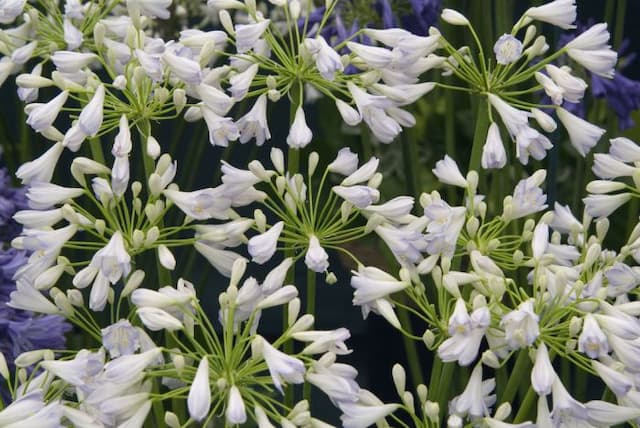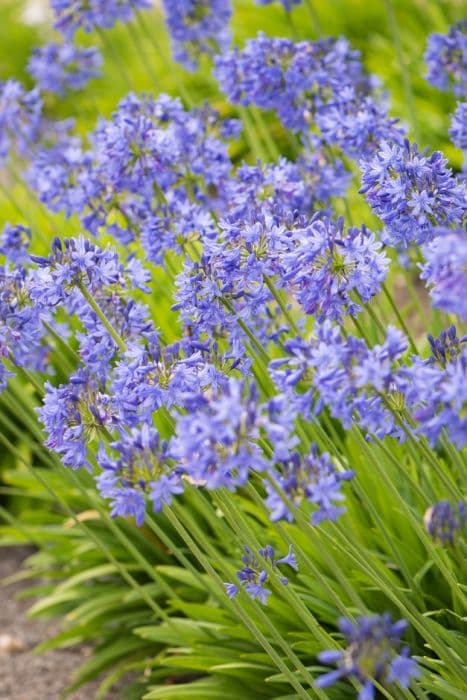African Lily Agapanthus 'Bridal Bouquet'

ABOUT
The Agapanthus 'Bridal Bouquet', commonly known as the Lily of the Nile, is a striking plant known for its lush, strap-like green leaves that form a dense clump, creating an attractive foliage display. Its most distinctive feature is its beautiful flower clusters, which consist of numerous small, trumpet-shaped flowers. These flowers are pure white, akin to the color one would associate with a bride's bouquet, hence the name 'Bridal Bouquet'. The purity of the white blooms is often enhanced by a soft bluish or lavender tinge, giving it a delicate and elegant appearance. The flowers are borne on sturdy, upright stems that rise gracefully above the foliage. These stems are accompanied by green, leaf-like bracts that add to the overall greenery of the plant. The blossoms are known for their tendency to bloom in rounded clusters or umbels, which provide a generous pop of color that can be easily spotted from a distance. The contrast between the dark green leaves and the bright white flowers is particularly eye-catching and makes for an attractive display in gardens and landscapes. The floral display is typically abundant and can last for several weeks, transforming the plant into a focal point when in bloom. The Lily of the Nile is not only appreciated for its aesthetic qualities but also for its ability to adapt to a variety of garden conditions, although it does prefer sunny locations that mimic its native environment. Moreover, the plant is relatively easy to care for, asking for minimal attention once established. It is often used in borders, as an accent plant, or in mass plantings where its ornamental features can be appreciated en masse. The beauty and the simplicity of the 'Bridal Bouquet' make it a popular choice for gardeners who wish to create a visually striking impact with a plant that embodies both lush foliage and captivating blooms.
About this plant
 Names
NamesFamily
Amaryllidaceae.
Synonyms
African Lily, Lily of the Nile, Love Flower.
Common names
Agapanthus 'Bridal Bouquet'
 Toxicity
ToxicityTo humans
The Agapanthus, commonly known as Lily of the Nile, is considered to have low toxicity to humans. If ingested, parts of the plant can cause symptoms such as nausea, vomiting, and diarrhea. In some cases, skin contact with the sap may lead to dermatitis or skin irritation. It is advisable to handle the plant with care and ensure that children do not consume any part of it.
To pets
The Agapanthus, or Lily of the Nile, is toxic to pets, including dogs and cats. If a pet ingests parts of this plant, it may exhibit symptoms such as nausea, vomiting, and diarrhea. In some cases, tremors or cardiac problems can occur, though this is less common. Care should be taken to prevent pets from accessing and ingesting any parts of the plant, as it could result in gastrointestinal upset or more severe health issues.
 Characteristics
CharacteristicsLife cycle
Perennials
Foliage type
Evergreen
Color of leaves
Green
Flower color
White
Height
2 feet (60 cm)
Spread
2 feet (60 cm)
Plant type
Bulb
Hardiness zones
8
Native area
South Africa
Benefits
 General Benefits
General Benefits- Attractive Flowers: Agapanthus 'Bridal Bouquet' produces beautiful white flowers that can enhance the aesthetics of gardens and landscapes.
- Drought Tolerance: Once established, this plant has a good tolerance to drought, making it suitable for xeriscaping and water-wise gardens.
- Easy to Grow: It is relatively easy to cultivate and does not require extensive care, making it accessible to gardeners of all skill levels.
- Long Blooming Period: It has a long flowering season, providing color and interest in the garden for an extended period.
- Deer Resistance: This plant is not a favorite of deer, reducing the risk of damage in areas where deer are prevalent.
- Attracts Pollinators: It attracts butterflies and bees, which are beneficial for pollination of plants in the garden.
- Container Gardening: Agapanthus is suitable for container gardening, allowing it to be grown on patios, balconies, and other confined spaces.
- Low Maintenance: It requires minimal maintenance once established, aside from occasional watering and feeding.
- Soil Versatility: Agapanthus 'Bridal Bouquet' can adapt to a variety of soil types, although it prefers well-drained soils.
- Erosion Control: Its root system can help stabilize slopes and areas prone to erosion.
 Medical Properties
Medical PropertiesThis plant is not used for medical purposes.
 Air-purifying Qualities
Air-purifying QualitiesThis plant is not specifically known for air purifying qualities.
 Other Uses
Other Uses- African Lily can be used as a natural ink or dye. The sap and flowers may be processed to create a blue or purple dye for textiles or artistic purposes.
- In colder regions, the dried seed heads of the African Lily can be sprayed with metallic paint and used as a permanent feature in flower arrangements.
- The flowers can be turned into an adornment for cakes or desserts, by crystalizing them with a thin layer of sugar for a decorative and edible treat.
- African Lily leaves can be woven into small baskets or mats in a process similar to that used for palm fronds or other fibrous plants.
- The tall, sturdy stalks of the African Lily can be dried and used in the construction of small garden ornaments or as structural supports for other plants.
- African Lily can be part of a living fence or privacy screen when planted in a dense row along the edge of a property.
- The plant can be used in companion planting, as its thick roots may help to stabilize the soil and provide support for neighboring, less sturdy plants.
- The sap from the leaves and stems, if thickened, can be used as a natural adhesive for small crafts and projects.
- Children can use the hollowed flower stalks of African Lily as a natural straw or to create small, simple musical instruments like flutes.
- The intense blue of the African Lily's flowers can be used in color therapy or visual meditation practices to promote a sense of tranquility and focus.
Interesting Facts
 Feng Shui
Feng ShuiThe African Lily is not used in Feng Shui practice.
 Zodiac Sign Compitability
Zodiac Sign CompitabilityThe African Lily is not used in astrology practice.
 Plant Symbolism
Plant Symbolism- Love Letters: The name Agapanthus is derived from the Greek words 'agape' meaning love, and 'anthos' meaning flower, symbolizing love letters or a message of love.
- Enduring Love: Often included in wedding bouquets, the Agapanthus represents lasting love and the commitment between two people.
- Beauty: With its striking blooms, the Agapanthus is commonly associated with beauty, elegance, and a delicate appearance.
- Fertility: The full, round umbels of the Agapanthus may represent fertility and abundance, making it a hopeful symbol for those desiring children.
- Prosperity: In some cultures, the Agapanthus is seen as a symbol of good fortune and prosperity due to its lush and bountiful flowers.
 Water
WaterThe Agapanthus, commonly known as the Lily of the Nile, should be watered thoroughly, allowing the soil to become moist but not soggy. During the active growing season in spring and summer, water the plant once every week with about one to two gallons of water, depending on the size of the plant and the weather conditions. Reduce watering to every two to three weeks in the fall and winter when the plant is dormant, using slightly less water to prevent root rot. Overwatering can lead to fungal issues, so ensure proper drainage. If the top two inches of soil are dry, it’s time to water again.
 Light
LightLily of the Nile thrives best in full sun to partial shade conditions. Ideally, position the plant in a spot that receives at least six hours of direct sunlight daily. However, in regions with extremely hot summers, slightly shading the plant during the peak afternoon hours can help prevent scorching of the leaves.
 Temperature
TemperatureThe Lily of the Nile prefers moderate to warm temperatures, thriving ideally between 60 and 80 degrees Fahrenheit. It can tolerate minimum temperatures down to about 50 degrees Fahrenheit, but frost or prolonged exposure below this temperature can be damaging. Ensure to provide protection or move the plant indoors in winter if you live in a zone with cold temperatures.
 Pruning
PruningPrune the Lily of the Nile to remove spent flower stalks and encourage a tidy growth habit. Cut back flower stems to the base after blooming, typically late summer or fall. Additionally, remove any dead or damaged foliage as needed. Pruning once a year is usually sufficient unless you need to shape the plant or remove damaged leaves more frequently.
 Cleaning
CleaningAs needed
 Soil
SoilLily of the Nile prefers well-draining soil enriched with compost; the ideal pH level for this plant is between 6.0 and 8.0. A mixture of two parts loam, one part perlite or sand, and one part compost or aged manure creates the optimal condition for growth.
 Repotting
RepottingLily of the Nile typically needs repotting every 2 to 3 years to refresh the soil and accommodate root growth. When repotting, select a pot that is only slightly larger than the previous one.
 Humidity & Misting
Humidity & MistingLily of the Nile thrives in average humidity levels typical of outdoor environments; it does not require any special humidity adjustments when grown in garden settings.
 Suitable locations
Suitable locationsIndoor
Provide bright light, well-draining soil and allow the topsoil to dry between waterings.
Outdoor
Plant in sun to part-shade, ensure soil is fertile and well-draining.
Hardiness zone
8-11 USDA
 Life cycle
Life cycleThe Agapanthus 'Bridal Bouquet', commonly known as Lily of the Nile or African Lily, starts its life as a seed, which, when sown in fertile soil and under the right conditions, germinates and sprouts into a seedling. As the seedling matures, it develops a clump of strap-shaped, green leaves, and a robust root system. After a few years of vegetative growth, once it is mature enough and conditions are favorable, typically in the summer months, it begins its flowering stage, producing tall, sturdy stems topped with rounded clusters of funnel-shaped, white flowers. Following the blooming period, these flowers may give way to seed pods if pollination occurs. After the seeds mature, the pods release them, and if they land in a suitable location, the cycle begins anew. In colder climates, the Agapanthus enters a period of dormancy in winter, during which above-ground growth dies back, and the plant survives through its rhizomes or rootstock until the next growing season.
 Propogation
PropogationPropogation time
Spring to early summer
The Agapanthus 'Bridal Bouquet', commonly known as Lily of the Nile, is often propagated by division, which is most successful in the spring or early summer when the plant has finished blooming. To propagate by division, carefully lift the plant from the ground and gently separate it into smaller clumps, ensuring that each new section has a portion of the roots attached. Replant the divisions immediately at the same depth they were originally growing, spacing them about 18 inches (approximately 45 centimeters) apart to allow for growth. Water the new plants thoroughly after planting to help establish them. Division not only propagates new plants but also rejuvenates older clumps that may have become too crowded. It's a straightforward and highly effective method for propagating Agapanthus 'Bridal Bouquet'.









![African lily [Brilliant Blue]](/_next/image?url=https%3A%2F%2Fplants-admin.emdemapps.com%2Fimages%2Fplants%2F%2Fimages%2F604b5e3c28e2b.png&w=640&q=75)